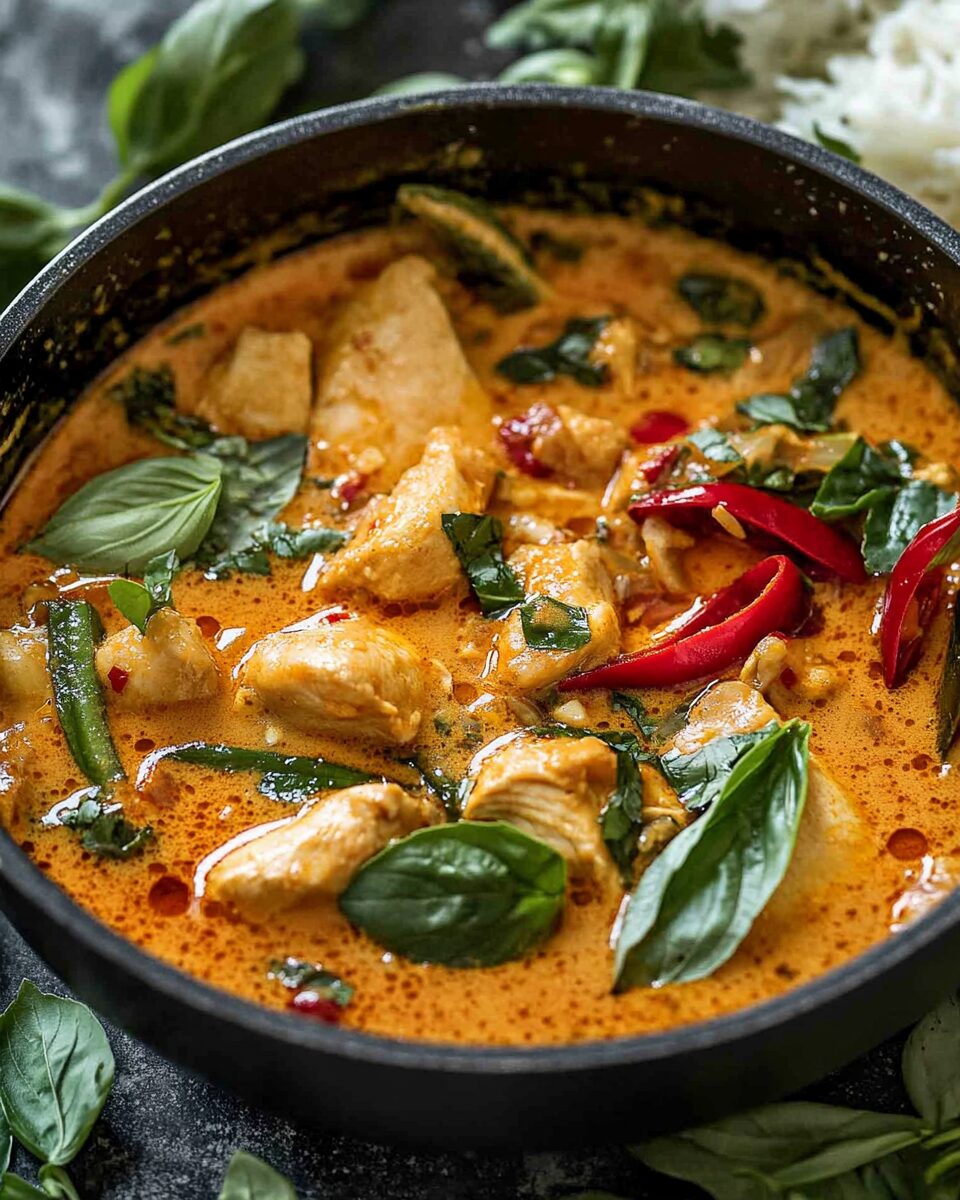The warm, complex aroma of Thai red curry simmering on the stove is a comforting embrace for your senses. This recipe delivers bold yet balanced flavor with a creamy coconut base, vibrant Thai herbs, and a mild spice that lingers just enough to keep you coming back for another bite.
Whether you’re a curry novice or a seasoned pro, this 30-minute dish is perfect for busy weeknights without compromising flavor. The rich sauce coats the tender chicken and sweet pumpkin, while the crunchy green beans add texture and color. Served over jasmine rice, it’s a soul-satisfying dish that brings Thai restaurant vibes straight to your kitchen.
Full Recipe:
-
3 tbsp vegetable oil (or canola or peanut oil)
-
5–6 tbsp Thai red curry paste (Maesri brand recommended)
-
2 large garlic cloves, minced
-
2 tsp fresh ginger, grated
-
1 tbsp lemongrass paste or finely chopped fresh lemongrass
-
1 cup (250 ml) low-sodium chicken broth
-
400 ml (14 oz) full-fat coconut milk
-
6 kaffir lime leaves
-
1 tbsp sugar (white, brown or palm)
-
2 tsp fish sauce (plus more to taste)
-
350g (12 oz) chicken thighs, boneless and skinless, thinly sliced
-
150g (5 oz) pumpkin or butternut squash, cubed
-
120g (4 oz) green beans, trimmed and halved
-
12 Thai basil leaves
Optional Garnishes & Serving:
-
Fresh red chili slices
-
Fresh coriander/cilantro leaves
-
Steamed jasmine rice
Directions:
-
Heat oil in a large skillet over medium-high heat.
-
Add the curry paste along with garlic, ginger, and lemongrass. Sauté for 2 minutes until fragrant.
-
Pour in the chicken broth, stirring well to dissolve the paste. Simmer rapidly for 3 minutes until the liquid reduces by half.
-
Stir in the coconut milk, kaffir lime leaves, sugar, and fish sauce.
-
Add chicken slices, spreading them out in the skillet. Simmer over medium heat for 8–10 minutes until the chicken is cooked and the sauce thickens.
-
Toss in pumpkin and green beans. Cook for another 3–4 minutes, or until the vegetables are just tender.
-
Remove from heat and stir in Thai basil leaves.
-
Serve hot over jasmine rice with chili and cilantro garnish, if desired.
Prep Time: 10 minutes | Cooking Time: 20 minutes | Total Time: 30 minutes
Kcal: 420 kcal | Servings: 4 servings
Introduction to Thai Red Curry with Chicken
Thai Red Curry with Chicken is one of the most iconic and universally loved dishes from Thai cuisine. Rich in flavor, incredibly aromatic, and visually vibrant, this dish is the perfect balance of spice, creaminess, and umami. It’s a comforting yet exotic meal that can easily be made at home, even on busy weeknights.
This curry stands out not only because of its luscious texture and stunning red hue but also because of its flexibility. While the core ingredients stay fairly consistent, it’s a dish that welcomes improvisation. Whether you’re adding vegetables like pumpkin, green beans, or even eggplant, or adjusting the level of heat to suit your palate, the result is always deeply satisfying.
For home cooks, especially those trying Thai food for the first time, this is one of the easiest ways to dive into Thai flavors. When prepared with a good-quality store-bought curry paste (or even better, homemade), and a few key pantry staples, this dish delivers restaurant-level taste without the complexity.
The Magic Behind Thai Red Curry
At its heart, Thai Red Curry is all about harmony. Thai cuisine emphasizes balancing the five key flavor elements: salty, sweet, sour, bitter, and umami. Red curry achieves this by combining a curry paste made from red chilies, garlic, lemongrass, galangal, and other aromatics with rich coconut milk, palm sugar, and fish sauce. Each component contributes to the final profile—spice from the chilies, earthiness from the herbs, salt from the fish sauce, and sweetness from the sugar.
What makes red curry different from its green or yellow counterparts is the choice of chilies and herbs. Red curry paste uses dried red chilies which offer a deeper, sometimes smokier flavor compared to the bright, herby taste of green curry. The result is a more mellow heat, often balanced with sweet vegetables like pumpkin or butternut squash.
Using Store-Bought Curry Paste (and How to Elevate It)
Many home cooks hesitate to try making Thai curry due to the complexity of sourcing and preparing traditional ingredients. Thankfully, good-quality curry pastes like the Maesri brand make it easy to enjoy authentic flavors without the extra effort.
However, store-bought pastes often lack the brightness of freshly made ones. To enhance the flavor, a common technique is to sauté the paste in oil along with fresh aromatics like garlic, ginger, and lemongrass before adding any liquid. This step awakens the spices, intensifies the flavor, and removes any rawness from the paste. By doing this, the dish instantly becomes more layered and aromatic—closer to the kind you’d find at a local Thai restaurant.
Coconut Milk: The Creamy Foundation
Coconut milk is a cornerstone of Thai red curry. Its creamy texture and natural sweetness are essential in softening the spice from the curry paste. Full-fat coconut milk is preferred for its richness, and it helps create a luxurious, silky sauce that coats the chicken and vegetables beautifully.
When simmered properly, coconut milk gives the curry a slightly split look—this is not a flaw, but a sign of authenticity. In traditional Thai cooking, this separation of oil is normal and even desirable, as it shows that the paste has cooked thoroughly and the flavors have developed deeply.
The Role of Vegetables in Red Curry
Thai Red Curry is highly adaptable, and the choice of vegetables can change based on what’s in season or available in your kitchen. In this particular version, pumpkin (or butternut squash) and green beans are used. Both are excellent additions—the pumpkin adds a delicate sweetness and creamy texture that blends into the sauce, while the green beans offer a pleasant crunch and freshness.
Other popular additions include bamboo shoots, eggplant (especially Thai eggplant if you can find it), carrots, bell peppers, or even baby corn. The key is to maintain a balance in texture and flavor, without overpowering the sauce.
Protein Options and Why Chicken Works Best
Chicken, particularly boneless skinless thighs, is often the protein of choice in Thai Red Curry for good reason. Thigh meat is more tender and juicy than breast meat and absorbs the flavors of the curry exceptionally well during simmering.
That said, this curry is just as delicious when made with other proteins such as prawns, tofu, pork, or beef. Tofu makes a great vegetarian alternative, especially when paired with mushrooms and extra vegetables. For pescatarians, seafood such as prawns or white fish adds a lovely, light touch to the rich curry base.
The Importance of Thai Basil and Lime Leaves
Fresh Thai basil and kaffir lime leaves are what elevate this dish from good to extraordinary. Thai basil has a subtle aniseed flavor that adds brightness and contrast to the creamy curry. Kaffir lime leaves, on the other hand, offer a citrusy aroma and depth that cannot be replicated by regular lime or lemon zest.
If you can’t find Thai basil, a small amount of regular basil will do in a pinch, though the flavor will be slightly different. Likewise, dried lime leaves can be used if fresh ones are unavailable, though they should be added early in the cooking process to allow them to rehydrate and infuse their essence.
Spice Level and Adjusting the Heat
Despite its fiery appearance, Thai Red Curry is often milder than people expect. The heat level is largely determined by the curry paste used. Some store-bought brands are quite mild, while others pack more punch.
If you’re sensitive to spice, start with a smaller amount of paste and add more as needed. You can also offset the heat with a bit more coconut milk or sugar. On the flip side, if you love spicy food, feel free to increase the amount of paste or even toss in some sliced fresh chilies before serving.
What to Serve with Thai Red Curry
Thai Red Curry is traditionally served with jasmine rice, which acts as the perfect vehicle to soak up the flavorful sauce. The slightly sticky texture of jasmine rice complements the creamy curry beautifully.
For a more indulgent twist, coconut rice adds another layer of sweetness and richness. If you’re looking for a lower-carb option, cauliflower rice or even steamed vegetables make good substitutes. A crisp Thai cucumber salad or a side of pickled vegetables can also help balance the richness of the curry.
Why Thai Red Curry Is So Popular
There’s a reason Thai Red Curry is one of the most ordered dishes at Thai restaurants around the world—it’s comforting, flavorful, and deeply satisfying. Whether you’re eating it on a rainy day or hosting a dinner for friends, it hits all the right notes: spicy, creamy, savory, and just a little sweet.
Its universal appeal comes from its ability to cater to different tastes. You can make it vegetarian, vegan, or protein-rich. You can make it spicy or mild. And most importantly, it doesn’t require hours in the kitchen, making it ideal for weeknight meals.
Conclusion
Thai Red Curry with Chicken is a masterpiece of balance and flavor. It combines the bold aromatics of Thai spices with the comforting richness of coconut milk, creating a dish that is both exotic and familiar. With a few simple techniques, even a jar of store-bought curry paste can be transformed into a restaurant-quality meal.
This dish invites creativity and customization. Once you master the base recipe, you can explore endless variations—different proteins, vegetables, and spice levels—to suit your mood or dietary preferences. But no matter how you tweak it, one thing remains the same: Thai Red Curry is pure comfort in a bowl.
Whether you’re new to Thai cooking or a seasoned curry lover, this dish deserves a regular spot in your meal rotation. It’s proof that with just a few simple ingredients and a bit of love, you can bring the magic of Thai cuisine right into your kitchen.





